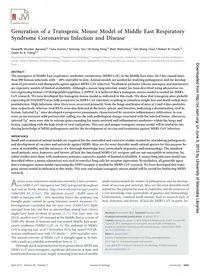
2015 Generation of a Transgenic Mouse Model of Middle East Respiratory Syndrome Coronavirus Infection and Disease PDF
Preview 2015 Generation of a Transgenic Mouse Model of Middle East Respiratory Syndrome Coronavirus Infection and Disease
Generation of a Transgenic Mouse Model of Middle East Respiratory Syndrome Coronavirus Infection and Disease Anurodh Shankar Agrawal,a Tania Garron,a Xinrong Tao,a Bi-Hung Peng,b Maki Wakamiya,c Teh-Sheng Chan,a Robert B. Couch,d Chien-Te K. Tsenga,e Department of Microbiology and Immunology,a Department of Pathology,b Transgenic Mouse Core Facility, Institute for Translational Sciences and Animal Resource Center,c Internal Medicine, Division of Infectious Disease,d and Center for Biodefense and Emerging Infectious Disease,e University of Texas Medical Branch, Galveston, Texas ABSTRACT The emergence of Middle East respiratory syndrome-coronavirus (MERS-CoV) in the Middle East since 2012 has caused more than 900 human infections with �40% mortality to date. Animal models are needed for studying pathogenesis and for develop- ment of preventive and therapeutic agents against MERS-CoV infection. Nonhuman primates (rhesus macaques and marmosets) are expensive models of limited availability. Although a mouse lung infection model has been described using adenovirus vec- tors expressing human CD26/dipeptidyl peptidase 4 (DPP4), it is believed that a transgenic mouse model is needed for MERS- CoV research. We have developed this transgenic mouse model as indicated in this study. We show that transgenic mice globally expressing hCD26/DPP4 were fully permissive to MERS-CoV infection, resulting in relentless weight loss and death within days postinfection. High infectious virus titers were recovered primarily from the lungs and brains of mice at 2 and 4 days postinfec- tion, respectively, whereas viral RNAs were also detected in the heart, spleen, and intestine, indicating a disseminating viral in- fection. Infected Tg� mice developed a progressive pneumonia, characterized by extensive inflammatory infiltration. In con- trast, an inconsistent mild perivascular cuffing was the only pathological change associated with the infected brains. Moreover, infected Tg� mice were able to activate genes encoding for many antiviral and inflammatory mediators within the lungs and brains, coinciding with the high levels of viral replication. This new and unique transgenic mouse model will be useful for fur- thering knowledge of MERS pathogenesis and for the development of vaccine and treatments against MERS-CoV infection. IMPORTANCE Small and economical animal models are required for the controlled and extensive studies needed for elucidating pathogenesis and development of vaccines and antivirals against MERS. Mice are the most desirable small-animal species for this purpose be- cause of availability and the existence of a thorough knowledge base, particularly of genetics and immunology. The standard small animals, mice, hamsters, and ferrets, all lack the functional MERS-CoV receptor and are not susceptible to infection. So, initial studies were done with nonhuman primates, expensive models of limited availability. A mouse lung infection model was described where a mouse adenovirus was used to transfect lung cells for receptor expression. Nevertheless, all generally agree that a transgenic mouse model expressing the DPP4 receptor is needed for MERS-CoV research. We have developed this trans- genic mouse model as indicated in this study. This new and unique transgenic mouse model will be useful for furthering MERS research. A severe acute respiratory syndrome caused by a new coronavi- rus (SARS-CoV) emerged in late 2002 and spread throughout Asia and to North America (http://www.who.int/csr/sars/country /table2004_04_21/en/). The infection caused �8,000 cases of SARS in humans with �10% mortality before the epidemic was brought under control by using infection control measures (1). Investigations concluded that the new virus (SARS-CoV) likely emerged from bats and that an intermediate animal host (civets) might have been involved in spread (2, 3). Ten years later (in 2012), another new CoV emerged in the Middle East as a cause of SARS-like disease in humans and was named Middle East respi- ratory syndrome (MERS)-CoV (4, 5). The outbreak of MERS- CoV is ongoing and, as of 5 November 2014, has caused 929 lab- oratory-confirmed cases with 372 deaths (� 40% mortality rate). The natural reservoir of MERS-CoV is thought again to be bats, with camels as a possible intermediate host (6, 7). Although much information has been gained about MERS and MERS-CoV since emergence, significant deficiencies in basic and translational research exist, largely stemming from lack of suitable small-animal models for studies of pathogenesis and for develop- ment of vaccines and antivirals. Mice are the most desirable small animal for this purpose because of availability and the existence of a vast knowledge base, particularly of genetics and immunology. Unfortunately, standard small animals used in research such as mice, hamsters, and ferrets, all lack the MERS-CoV receptor, hu- Received 26 November 2014 Accepted 9 January 2015 Accepted manuscript posted online 14 January 2015 Citation Agrawal AS, Garron T, Tao X, Peng B-H, Wakamiya M, Chan T-S, Couch RB, Tseng CK. 2015. Generation of a transgenic mouse model of Middle East respiratory syndrome coronavirus infection and disease. J Virol 89:3659–3670. doi:10.1128/JVI.03427-14. Editor: A. García-Sastre Address correspondence to Chien-Te K. Tseng,
